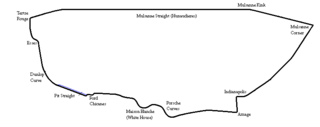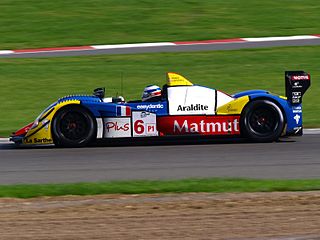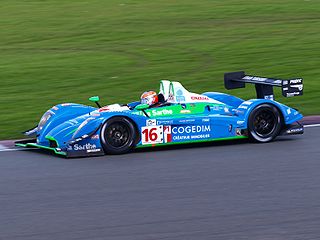
The DFV is an internal combustion engine that was originally produced by Cosworth for Formula One motor racing. The name is an abbreviation of Double Four Valve, the engine being a V8 development of the earlier four-cylinder FVA, which had four valves per cylinder.

The 1988 24 Hours of Le Mans was the 56th Grand Prix of Endurance as well as the fifth round of the 1988 World Sports-Prototype Championship. It took place at the Circuit de la Sarthe, France, on the 11 and 12 June 1988. At their third attempt, Jaguar arrived with five cars to take on the strong Porsche works team of three cars, in their only race for the Championship season. The other potential rival was Sauber, now formally backed by Mercedes-Benz, but after a major high-speed tyre-blowout in practice, their two-car team was withdrawn.

The 1987 24 Hours of Le Mans was the 55th Grand Prix of Endurance as well as the fifth round of the 1987 World Sports-Prototype Championship. It took place at the Circuit de la Sarthe, France, on the 13 and 14 June 1987. Jaguar was a strong contender, have won the four preceding rounds of the Championship. The Porsche works team had installed a new 3-litre engine into their 962s but their turbo engines would test their fuel economy.

The 1986 24 Hours of Le Mans was the 54th Grand Prix of Endurance as well as the third round of the 1986 World Sports-Prototype Championship. It took place at the Circuit de la Sarthe, France, on 31 May and 1 June 1986. This year saw the return of a full Jaguar works team, to take on the strong Porsche works and customer teams. However, with the fuel regulations relaxed, the turbo-charged cars would be able to use more of their potential power to outrun the normally-aspirated 6-litre Jaguars.

The 1984 24 Hours of Le Mans was the 52nd Grand Prix of Endurance, and took place on 16 – 17 June 1984. It was also the third round of the 1984 World Endurance Championship. There were two big stories going into the race weekend: the absence of the Porsche works team and their drivers, and the return of Jaguar. Bob Tullius had commissioned the new Jaguar XJR-5 to run in the IMSA series and entered two for Le Mans. Earlier in the year, FISA had announced abrupt changes to the fuel regulations to bring them more in line with IMSA. Porsche and Lancia objected strongly because of their strong investment in the existing rules. In the absence of dominant Porsche works team, the race was left wide open between Lancia and the number of strong Porsche customer teams.

The 1983 24 Hours of Le Mans was a motor race staged at the Circuit de la Sarthe, Le Mans, France on 18 and 19 June 1983. It was the 51st Grand Prix of Endurance and was also the fourth round of both the 1983 World Endurance Championship and the 1983 European Endurance Championship. The 1983 race was held eight days before the 60th anniversary of the inaugural race held in 1923.

The 1982 24 Hours of Le Mans was the 50th Grand Prix of Endurance, which took place on 19 and 20 June 1982. It was also the fourth round of the 1982 World Endurance Championship. As well as a significant anniversary, this was a watershed year for Le Mans, with the highly anticipated advent of the FIA's Group C regulations, the essence of which was to allow an open engine formula but a minimum weight for safety and a proscribed fuel allocation.

The 1981 24 Hours of Le Mans was the 49th Grand Prix of Endurance, and took place on 13 and 14 June 1981. It was also the eighth round of the World Endurance Championship of Drivers, and the fifth round of the World Championship for Makes.

The 1980 24 Hours of Le Mans was the 48th Grand Prix of Endurance, and took place on 14 and 15 June 1980. It was the seventh round of both the World Championship for Makes and World Challenge for Endurance Drivers. With neither the Porsche nor Renault works teams contesting the big Group 6 sports-cars for outright victory, it left the prospects open for a privateer victory from Joest, Rondeau or De Cadenet, or from Group 5 again, if they were to fail. The wet weather throughout the race further added to the uncertainty, reducing the advantage of the more powerful cars.

The 1979 24 Hours of Le Mans was the 47th Grand Prix of Endurance, and took place on 9 and 10 June 1979. With no other major works cars this year, the Porsche team were the strong favourites to win. Their competition would be from Cosworth-powered Mirages and Rondeaus and a swarm of Group 5 and IMSA-class Porsche 935s. The other big talking point was the presence of Hollywood actor Paul Newman, driving for Dick Barbour Racing.

The 1978 24 Hours of Le Mans was the 46th Grand Prix of Endurance, and took place on 10 and 11 June 1978. In many ways it was a continuation of the race from the year before – the two main protagonists would be the very evenly-matched works teams of Alpine-Renault and Porsche, with four cars each. The race was not valid for any championship.

The 1976 24 Hours of Le Mans was the 44th Grand Prix of Endurance, and took place on 12 and 13 June 1976. This year the FIA introduced its new Group 5 and Group 6 regulations and the race was now open to nine distinct classes, although it was still not part of the World Championship seasons. Porsche introduced its new models, the 936 in Group 6, the 935 in Group 5 and the 934 in Group 4. In response, BMW had its modified 3.0 CSL in Group 5. It was the year that turbos arrived in considerable numbers, with over a dozen turbocharged entries, led by the Renault Alpine A442. It saw the arrival of French prototype manufacturers Jean Rondeau and Gérard Welter in a new GTP class and a first-time invitation to American IMSA and NASCAR entries.

The 1974 24 Hours of Le Mans was the 42nd Grand Prix of Endurance, and took place on 15 and 16 June 1974. It was the fifth round of the 1974 World Championship for Makes. After Alfa Romeo had won the first race of the season at Monza, it had been Matra all the way and they came to Le Mans as firm favourites for a third consecutive outright victory, especially after Alfa Romeo withdrew its cars just before raceweek.

The 1973 24 Hours of Le Mans was the 41st Grand Prix of Endurance and took place on 9 and 10 June 1973. It was the eighth round of the 1973 World Championship of Makes.

Jean Rondeau was a French race car driver and constructor, who won the 24 Hours of Le Mans in 1980, in a car bearing his own name, an achievement which remains unique in the history of the race.

Courage Compétition was a racing team and chassis constructor company now owned by Oreca, based in Le Mans, France, near the Circuit de la Sarthe. It was founded by Yves Courage, a French race driver who ran hillclimbs before founding the company. Following the purchase of Courage by Oreca in 2007, Yves Courage has refounded the company as Courage Technology in 2010, attempting to develop electric racing cars.

The Pescarolo 01 was the first sports prototype racing car built entirely by French team Pescarolo Sport. It had been designed to meet the LMP1 and LMP2 regulations for Le Mans Prototypes in the Le Mans Series as well as at the 24 Hours of Le Mans, and replace Pescarolo's previous C60 chassis which had been heavily modified from cars purchased through Courage Compétition. The 01s debut was at the 2007 1000 km of Monza.

The March 701 is a Formula One racing car model, designed by Robin Herd with Peter Wright, and built by March Engineering. The 701 was March's first Formula One design – following their one-off March 693P Formula Three prototype of 1969 – and was designed and built in only three months. The March 701 made its race debut a month after its public unveiling, at the 1970 South African Grand Prix. In total, eleven 701s were constructed, with March supplying many privateer entrants as well as their own works team. The 701's career started well, March drivers taking three wins and three pole positions from the car's first four race entries, but lack of development through the 1970 Formula One season resulted in increasingly poor results as the year wore on. The 701 was superseded by the March 711 in 1971, and made its last World Championship race appearance at the 1971 Italian Grand Prix.

The Rondeau M382 was a Group C prototype sports car, designed, developed and built by Automobiles Jean Rondeau in 1981, and used in sports car racing between 1982 and 1986.

The Rondeau M379 is a Group 6 sports prototype race car, designed, developed and built by Automobiles Jean Rondeau, and competed in sports car racing between 1979 and 1988. It also notably successfully won the 24 Hours of Le Mans in 1980. During the 1981 24 Hours of Le Mans, two cars finished on the podium, but the race was marred by the death of Jean-Louis Lafosse, driving one of the five M379s entered in the event. It achieved one further win, at Monza in 1988. It scored a total of five podium finishes, and three class wins. It was powered by a 3.0 L (180 cu in), 460 hp (340 kW), Ford-Cosworth DFV V8 Formula One engine.The chassis is an aluminum-reinforced steel spaceframe, covered in a fiberglass panel body. This drove the rear wheels through a Hewland 5-speed manual transmission. This meant it was very light, with the total weight coming to 760 kg (1,680 lb).

















